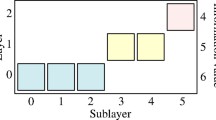Abstract
Throughput limitation of wireless networks imposes many practical problems as a result of wireless media broadcast nature. The solutions of the problem are mainly categorized in two groups; the use of multiple orthogonal channels and network coding (NC). The networks with multiple orthogonal channels and possibly multiple interfaces can mitigate co-channel interference among nodes. However, efficient assignment of channels to the available network interfaces is a major problem for network designers. Existing heuristic and theoretical work unanimously focused on joint design of channel assignment with the conventional transport/IP/MAC architecture. Furthermore, NC has been a prominent approach to improve the throughput of unicast traffic in wireless multi-hop networks through opportunistic NC. In this paper we seek a collaboration scheme for NC in multi-channel/interface wireless networks, i.e., the integration of NC, routing and channel assignment problem. First, we extend the NC for multiple unicast sessions to involve both COPE-type and a new proposed scheme named as Star-NC. Then, we propose an analytical framework that jointly optimizes the problem of routing, channel assignment and NC. Our theoretical formulation via a linear programming provides a method for finding source–destination routes and utilizing the best choices of different NC schemes to maximize the aggregate throughput. Through this LP, we propose a novel channel assignment algorithm that is aware of both coding opportunities and co-channel interference. Finally, we evaluate our model for various networks, traffic models, routing and coding strategies over coding-oblivious routing.










Similar content being viewed by others
Notes
Weighted cumulative expected transmission time.
References
Alicherry, M, Bhatia, R., & Li, L. (2005). Joint channel assignment and routing for throughput optimization in multi-radio wireless mesh networks. In Proceedings of ACM MobiCom.
Wi, H., Yang, F., Tan, K., Chen, J., Zhang, Q., & Zhang, Z. (2006). Distributed channel assignment and routing in multiradio multichannel multihop wireless networks. IEEE Journal on Selected Areas in Communications, 24, 11.
Kyasanur, P., & Vaidya, N. (2005). Routing and interface assignment in multichannel multi-interface wireless networks. In Proceedings of IEEE WCNC.
Tang, J. Xue, G. & Zhang, W. (2005). Interference-aware topology control and qos routing in multi-channel wireless mesh networks. In Proceedings of ACM MobiHoc.
Rad, A. H. M., & Wong, V. W. (2007). Joint Channel allocation, interface assignment and MAC design for multi-channel wireless mesh networks. In Proceedings of IEEE INFOCOM.
Lin, X. & Rasool, S. (2007). A distributed joint channel-assignment, scheduling and routing algorithm for multi-channel ad hoc wireless networks. In Proceedings of IEEE INFOCOM.
Rad, A. H. M., & Wong, V. W. (2006). Joint optimal channel assignment and congestion control in multi-channel wireless mesh networks. In Proceedings of IEEE ICC.
Ahlswede, R., Cai, N., Li, S.-Y. R., & Yeung, R. W. (2000). Network information flow. IEEE Transactions on Information Theory, 46(1), 1204–1216.
Li, S. R., Yeung, & Cai, R. W. N. (2003). Linear network coding. IEEE Transaction on information Theory, 49(2), 371–381.
Li, Z. & Li, B. (2004). Network coding in undirected networks. In Proceedings of CISS.
Li, Z. & Li, B. (2004). Network coding: The case for multiple unicast sessions. In Proceedings of Allerton Conference on Communications.
Koetter, R., & Ho, T. (2005). Online incremental network coding for multiple unicasts. In Proceedings of DIMACS Working Group on Network Coding.
Wu, Y., Chou, P. A., & Kung, S. Y. (2004) Information Exchange in Wireless Networks with Network Coding and Physical-layer Broadcast. MSR-TR-78.
Katti, S., Rahul, H., Hu, W., Katabi, D., Medard, M., & Crowcroft, J. (2008). XOR in the air: Practical wireless network coding. IEEE/ACM Transactions on Networking, 16, 497–510.
Sengupta, S., Rayanchu, S., & Banerjee, S. (2007). An analysis of wireless network coding for unicast sessions: The case for coding-aware routing. In Proceedings of IEEE INFOCOM.
Zhang, H., & Su, X. (2009). Modeling throughput gain of network coding in multi-channel multi-radio wireless ad hoc networks. International Journal of Selected Area in Communications, 27(5), 593–605.
Zhang, X., & Li, B. (2009). Optimized multipath network coding in lossy wireless networks. IEEE Journal on Selected Areas in Communications, 27(5), 622–634.
Das, A. K., Alazemi, H. M. K., Vijayakumar, R., & Roy, S. (2005). Optimization models for fixed channel assignment in wireless mesh networks with multiple radios. In Proceedings of IEEE SECON.
Zhang, X., & Li, B. (2008). On the benefits of network coding in multi-channel wireless networks. In Proceedings of IEEE INFOCOM.
Draves, R., Padhye, J., & Zill, B. (2004). Routing in multi-radio, multi-hop wireless mesh networks. In ACM MOBICOM.
Henderson, D., Jacobson, S. H., & Johnson, A. W. (2006). The theory and practice of simulated annealing, Chapter 10.
Kwon, S., Hendessi, F., & Fekri, F. (2009). Cooperative network coding and coding-aware channel assignment in multi-channel, multi-interface wireless networks. In Proceedings of IEEE SECON.
Kwon, S., Hendessi, F., Fekri, F., & Stüber, G. L. (2011). A novel collaboration scheme for multi-channel/interface network coding. IEEE Transactions on Wireless Communications, 10(1), 188–198.
Fragouli, C., Katabi D., Markopoulou, A., Medard, M. & Rahul, H. (2007). Wireless network coding: Opportunities and challenges. In MILCOM.
Gupta, R., & Kumar, P. R. (2000). The capacity of wireless networks. IEEE Transactions on Information Theory, 46(2), 388–404.
De Couto, D. S. J., Aguayo, D., Bicket, J., & Morris, R. (2003). A high-throughput path metric for multi-hop wireless routing. In Proceedings ACM MOBICOM, pp. 134–146.
West, D. B. (2001). Introduction to graph theory (2nd ed., pp. 150–170). Englewood Cliffs, NJ: Prentice Hall Inc.
AMPL: A Modeling Language for Mathematical Programming. http://www.ampl.com/. [Online] IBM Inc.
CPLEX, ILOG. http://www.ilog.com. [Online] ILOG Inc.
Author information
Authors and Affiliations
Corresponding author
Rights and permissions
About this article
Cite this article
Shafieinejad, A., Hendessi, F. & Fekri, F. Network coding for multiple unicast sessions in multi-channel/interface wireless networks. Wireless Netw 19, 891–911 (2013). https://doi.org/10.1007/s11276-012-0508-2
Published:
Issue Date:
DOI: https://doi.org/10.1007/s11276-012-0508-2




